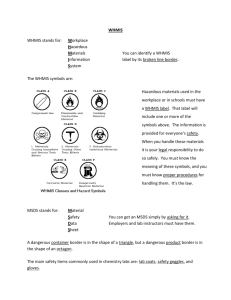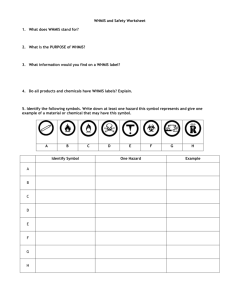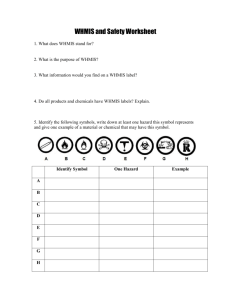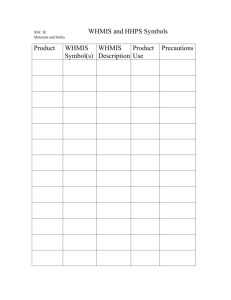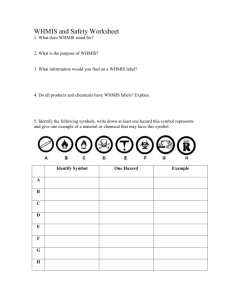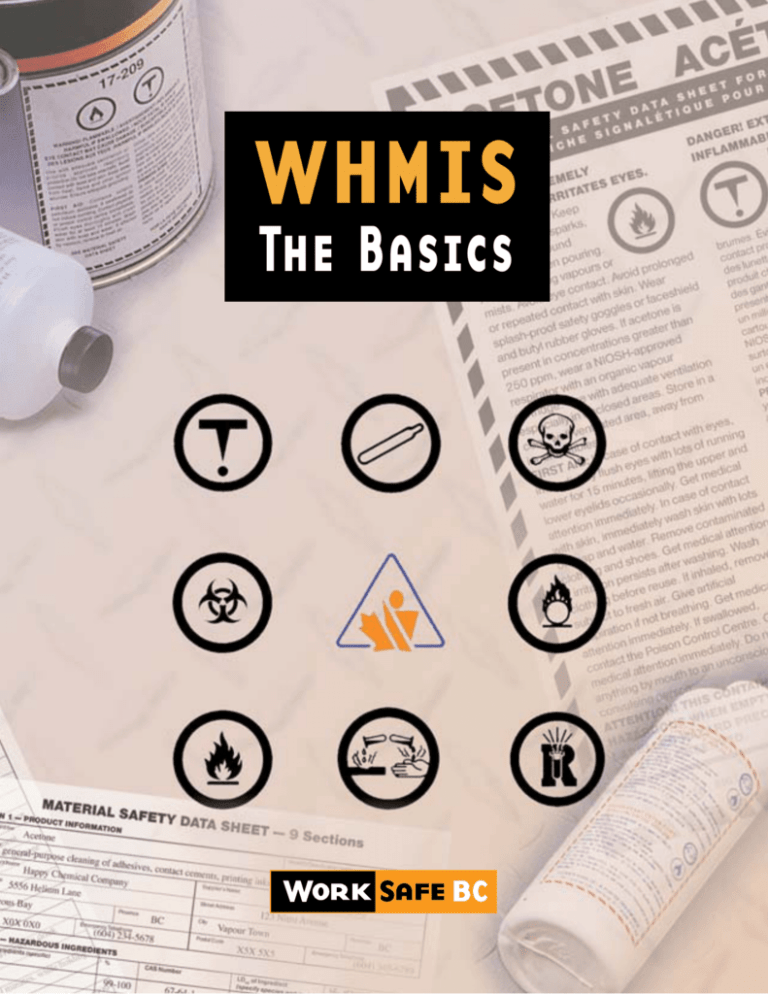
WHMIS
The Basics
About WorkSafeBC
WorkSafeBC (the Workers’ Compensation Board) is an independent provincial statutory agency
governed by a Board of Directors. It is funded by insurance premiums paid by registered employers
and by investment returns. In administering the Workers Compensation Act, WorkSafeBC remains
separate and distinct from government; however, it is accountable to the public through government
in its role of protecting and maintaining the overall well-being of the workers’ compensation system.
WorkSafeBC was born out of a compromise between BC’s workers and employers in 1917 where
workers gave up the right to sue their employers or fellow workers for injuries on the job in return
for a no-fault insurance program fully paid for by employers. WorkSafeBC is committed to a safe
and healthy workplace, and to providing return-to-work rehabilitation and legislated compensation
benefits to workers injured as a result of their employment.
WorkSafeBC Prevention Information Line
The WorkSafeBC Prevention Information Line can answer your questions about workplace health
and safety, worker and employer responsibilities, and reporting a workplace accident or incident. The
Prevention Information Line accepts anonymous calls.
Phone 604 276-3100 in the Lower Mainland, or call 1 888 621-7233 (621-SAFE) toll-free in British
Columbia.
To report after-hours and weekend accidents and emergencies, call 604 273-7711 in the Lower Mainland,
or call 1 866 922-4357 (WCB-HELP) toll-free in British Columbia.
WHMIS
The Basics
WorkSafeBC publications
Many publications are available on the WorkSafeBC web site. The Occupational Health and Safety
Regulation and associated policies and guidelines, as well as excerpts and summaries of the Workers
Compensation Act, are also available on the web site: <www.worksafebc.com>
Some publications are also available for purchase in print:
Phone:
604 232-9704
Toll-free phone:
1 866 319-9704
Fax:
604 232-9703
Toll-free fax:
1 888 232-9714
Online ordering:
<www.worksafebc.com> and click on Publications; follow the links for ordering
© 2005 Workers’ Compensation Board of British Columbia. All rights reserved. The Workers’
Compensation Board of B.C. encourages the copying, reproduction, and distribution of this document
to promote health and safety in the workplace, provided that the Workers’ Compensation Board of B.C.
is acknowledged. However, no part of this publication may be copied, reproduced, or distributed for
profit or other commercial enterprise, nor may any part be incorporated into any other publication,
without written permission of the Workers’ Compensation Board of B.C.
2005 edition
Library and Archives Canada Cataloguing in Publication Data
Main entry under title:
WHMIS, the basics. -- 2005 Irregular.
“Worksafe BC.”
ISSN 1715-5940 = WHMIS, the basics
1. Workplace Hazardous Materials Information System (Canada). 2. Hazardous
substances - Labeling - Canada. 3. Hazardous substances - Canada - Safety measures.
4. Hazardous substances - Law and legislation - Canada. I. Workers’ Compensation
Board of British Columbia.
II. Title: Workplace Hazardous Materials Information System, the basics.
T55.3.H3W45
363.17’7’0971
C2005-960192-2
Contents
WHMIS the Basics ...................................................1
Overview of WHMIS ................................................2
Hazardous Materials ............................................................................. 3
Legislation ............................................................................................... 3
WHMIS Elements. ................................................................................. 4
Key WHMIS Participants ...................................................................... 5
Classification .........................................................6
Classes and Symbols ............................................................................ 6
Exemptions ...........................................................................................11
Labels.................................................................... 13
WHMIS Labels ..................................................................................... 13
Supplier Label ......................................................................................14
Acceptable Format for the Supplier Label ........................................ 15
Workplace Labels ................................................................................. 17
Other Means of Identification ............................................................ 18
Material Safety Data Sheet (MSDS) ..................... 19
MSDS Information ............................................................................... 19
9-Section MSDS — Sample Format ................................................... 21
Trade secrets ......................................................................................... 25
WHMIS Implementation ........................................26
WHMIS Program ................................................................................. 26
Education and Training ...................................................................... 27
Exercises ..............................................................29
Classification Exercise ......................................................................... 30
Label Exercise ....................................................................................... 31
MSDS Exercise..................................................................................... 33
Answer Keys .........................................................35
Classification Exercise Answers......................................................... 36
Label Exercise Answers ...................................................................... 37
MSDS Exercise Answers .................................................................... 38
Appendix ...............................................................39
Information Items on a Supplier Label ............................................. 39
WHMIS: The Basics
-v-
WHMIS The Basics
This booklet will explain the basics of Workplace Hazardous Materials
Information System (WHMIS), including:
• Overview—background to WHMIS development, key elements, and
key participants
• Classification—hazard classes and symbols; exempt products
• Labels—supplier labels, workplace labels, and other identifiers
• Material Safety Data Sheet (MSDS)—use, content, format, example,
and trade secrets
• Education/Implementation—WHMIS Program; education and
training
The overall purpose of WHMIS is to help ensure a safer, healthier
workplace. Your knowledge about the workplace is your biggest asset in
successfully understanding and benefiting from WHMIS.
Workers who are successfully educated and trained in WHMIS should
be able to answer these four questions:
• What are the hazards associated with controlled products? (For
example, How can it hurt me?)
• How do I protect myself? (For example, What should I wear?)
• What should I do in an emergency? (For example, What do I do if I
spill it?)
• Where do I get more information?
By understanding the information in this book, you will learn where to
look on the label of a controlled product, where to look on a Material
Safety Data Sheet, and what to discuss with your supervisor.
WHMIS: The Basics
-1-
Overview of WHMIS
The Workplace Hazardous Materials Information System (WHMIS)
provides information about many hazardous materials used in the
workplace. WHMIS calls these hazardous materials controlled products.
WHMIS
➢
WORKPLACE
ƒ deals only with products used
in the workplace
➢
H AZARDOUS M ATERIALS
ƒ dangerous products that may
cause fires, explosions, or
health problems
➢
I NFORMATION SYSTEM
ƒ provides information about
hazardous materials
Under WHMIS, workers have the right to receive information about
each controlled product they use — its identity, hazards, and safety
precautions. The goal of WHMIS is to reduce injury and disease by
communicating specific health and safety information about controlled
products so that the information can be used to reduce exposure to
hazardous materials.
WHMIS: The Basics
-2-
Hazardous Materials
Exposure to hazardous materials can result in health problems such as
irritation of the eyes, sensitization of the skin or lungs, heart ailments,
kidney and lung damage or cancer. Hazardous materials can cause
fires, explosions, or other accidents when improperly stored or handled.
Legislation
Federal Legislation (Hazardous Products Act and Controlled Products
Regulations) deals with importation and sale of controlled products. The
Hazardous Materials Information Review Act established a commission to
review claims for trade secrets.
Provincial Legislation (Occupational Health and Safety Regulation) covers
the use of hazardous materials in the workplace.
BACKGROUND
➢ Nationwide system implemented at the
federal and provincial levels in 1988
➢ Recognizing the interests of all
concerned
ƒ
ƒ
ƒ
ƒ
government (regulators)
industry (suppliers)
owners (employers)
labour (workers)
➢ Three key elements
ƒ labels
ƒ material safety data sheets (MSDS)
ƒ worker education and training
WHMIS: The Basics
-3-
WHMIS Elements
WHMIS controlled products are classified by their hazard. There are
six hazard classes and eight hazard symbols that identify the specific
hazards. (There are three symbols in Class D.) The eight hazard
symbols identify the specific hazards of controlled products. After a
controlled product has been classified, the following three WHMIS
elements are used to communicate health and safety information:
•
•
•
WHMIS labels: Labels on controlled products alert workers to the
identity of the product, hazards, and precautionary measures.
Material Safety Data Sheets (MSDS): Technical bulletins provide
detailed hazard and precautionary information.
WHMIS education and training programs: The employer provides
education and training for workers so that they can work safely
with and near controlled products. Workers need to know how
WHMIS works, the hazards of controlled products in their
workplace, and the safe work procedures they must follow.
3 BASIC ELEMENTS OF WHMIS
➢
Labels
➢
Material Safety Data Sheets (MSDS)
➢
Education and Training
WHMIS: The Basics
-4-
Key WHMIS Participants
The key WHMIS participants are suppliers, employers, and workers —
all have specific responsibilities.
PARTICIPANTS
➢
SUPPLIERS
ƒ classify all controlled products
ƒ supply proper labels and MSDS
ƒ keep information on labels and MSDS current
➢
EMPLOYERS
ƒ educate and train workers
ƒ provide safe work procedures
ƒ ensure availability of proper up-to-date labels and MSDS
➢
WORKERS
ƒ understand content and significance of labels and MSDS
ƒ follow safe work procedures
ƒ notify employers about problems with labels and MSDS
WHMIS: The Basics
-5-
Classification
Classification determines if a product falls within one or more of the
hazard classes. Suppliers classify controlled products and apply hazard
symbols.
Classes and Symbols
WHMIS covers six classes of controlled products, that are lettered A
through F. Eight hazard symbols are used to depict the specific hazards
within these different classes. (Class D contains three hazard symbols.)
Note: the products, substances, and materials listed in each of the
following graphics are examples only.
CLASS A
COMPRESSED GASES
➢
Products under pressure
ƒ butane, propane, acetylene,
and fire extinguishers
Hazards
If a pressurized container is punctured because it is dropped or
exposed to excessive heat, the exploding fragments or rocket-like
projectiles present a serious physical hazard. Examples include chlorine
contained in a pressurized cylinder and used as a disinfectant at
swimming pools, and oxygen used in oxyacetylene welding.
WHMIS: The Basics
-6-
CLASS B
FLAMMABLE/COMBUSTIBLE MATERIALS
➢
Substances capable of catching fire
ƒ acetone, isopropyl alcohol,
stoddart solvent
Hazards
These materials can pose a danger of fire and explosion. Flammables
are more dangerous than combustibles because they ignite more easily.
During use, they must be kept away from ignition sources such as
sparks or open flames. When not in use, they must be stored in fireresistant cabinets or other specified storage areas.
CLASS C
OXIDIZERS
➢
Products causing/contributing to
the combustion of other materials
ƒ hydrogen peroxide, potassium nitrate,
sodium chlorate
Hazards
Oxidizing materials greatly increase the risk of fire if they come in
contact with materials that can burn. They should never be stored near
flammable or combustible materials.
WHMIS: The Basics
-7-
Class D: Poisonous and
Infectious Materials
D1
➢
Materials causing immediate
and serious toxic effect
ƒ arsenic, methylene chloride, formaldehyde
Hazards
Materials causing death or immediate injury. Examples include highly
toxic sodium cyanide, used in the electroplating industry, which can be
absorbed through the skin. The toxic gas, hydrogen sulphide, used in
laboratories and present in petroleum and pulp and paper industries,
can cause death when inhaled.
D2
➢
Materials causing other toxic effect
- immediate skin or eye irritation
- chronic health effects on body organs,
cardiovascular or nervous system
ƒ carcinogens (asbestos, crystalline
silica, benzene) sensitizers (methyl
methacrylate) embroyotoxin (xylene)
Hazards
Poisonous and infectious materials causing immediate skin or eye
irritation or long-term health problems, such as skin/lung allergic
response, birth defects, cancer, reproductive problems, or impairment of
body organs and systems.
WHMIS: The Basics
-8-
D3
➢
Biohazardous infectious materials
- harmful microorganisms
ƒ Classified as Risk Groups II, III, or IV as
defined by the Medical Research Council
of Canada
ƒ Includes commercial cultures containing
infectious organisms such as HIV, Ebola,
and Hepatitis B
Hazards
Microorganisms (includes viruses, bacteria, fungi) causing disease
in persons and animals. They may be present in cultures. Products
containing biohazardous infectious materials may be found in
laboratory and research facilities associated with the medical or
agricultural sectors.
CLASS E
CORROSIVE MATERIALS
➢
Materials such as caustics or acids
causing burns to skin or eyes
ƒ sodium hydroxide, bleach, hydrochloric
acid, hydrofluoric acid
Hazards
Corrosive materials include caustics such as lye and acids. They can
cause permanent damage (e.g., burns) to skin and eyes.
WHMIS: The Basics
-9-
CLASS F
DANGEROUSLY REACTIVE MATERIALS
➢
Products that can undergo
dangerous reaction if subject to heat,
light, pressure, shock, water, air
ƒ hydrogen cyanide, benzoyl peroxide,
chlorine dioxide
Hazards
This class includes products that can undergo vigorous polymerization
reaction on their own, or become self-reactive when exposed to shock
or to increase in pressure or temperature. It also includes products that
react vigorously with water to release a toxic gas.
WHMIS: The Basics
- 10 -
Exemptions
Partially Exempt
Some products are already covered by other labelling legislation and do
not require WHMIS labels and MSDSs. However, Provincial legislation
requires employers to educate and train workers about the hazards
of partially exempt products and in safe work procedures, and to use
workplace labels.
PARTIALLY EXEMPT
No WHMIS Supplier Label and MSDS Required
EDUCATION & TRAINING AND WORKPLACE LABELS REQUIRED
➢
SOME CONSUMER
P RODUCTS
➢
R ADIOACTIVE
SUBSTANCES
➢
COSMETICS
➢
P ESTICIDES
➢
FOOD
➢
EXPLOSIVES
➢
MEDICAL DEVICES
AND
DRUGS
WHMIS: The Basics
- 11 -
Completely Excluded
Some products are completely excluded from both Federal and
Provincial WHMIS requirements. However, workers must be advised
of hazards and trained in safe handling procedures, as required under
other provisions of the Occupational Health and Safety Regulation.
COMPLETELY EXCLUDED
None of the WHMIS Requirements Apply
OH&S REGULATION APPLIES
➢
WOOD
AND
MADE OF
P RODUCTS
➢
TOBACCO AND
TOBACCO P RODUCTS
➢
H AZARDOUS
WASTES
WOOD
➢
M ANUFACTURED
A RTICLES
➢
GOODS H ANDLED UNDER TDG
ƒ hazardous materials in transport
WHMIS: The Basics
- 12 -
Labels
WHMIS Labels
The purpose of labels is to alert workers to the main hazards of
controlled products and provide instructions for safe handling, and to
direct workers to the MSDS for more information.
The two types of WHMIS labels are the supplier label and the
workplace label. Other means of identification may be used where
appropriate (such as warning signs, colour codes, placards).
WHMIS LABELS
➢
All WHMIS controlled products must be labelled
➢
There are 2 types of WHMIS Labels
ƒ Supplier Labels
ƒ Workplace Labels
➢
Other means of identification
ƒ placards, warning signs, colour codes
➢
Labels alert workers to hazards and safe handling
instructions
WHMIS: The Basics
- 13 -
Supplier Label
Suppliers must provide supplier labels on containers of all controlled
products sold or imported for use in the workplace.
• Supplier labels will show seven types of information within the
WHMIS hatched borders.
• The written information must be shown in both English and French.
• The label must stand out from the container itself and other
markings on the container (for example, the size of the label should
be appropriate for the size of the container).
SUPPLIER LABEL
➢
Contains the following:
ƒ Product name
ƒ Hazard symbols
ƒ Risk phrases
ƒ Precautionary measures
➢
ƒ First aid measures
ƒ Supplier identifier
ƒ Reference to MSDS
All information must be disclosed in English and French
within a hatched border
WHMIS: The Basics
- 14 -
Acceptable Format for the Supplier Label
[2] Hazard
Symbol(s)
[1] Product
Identifier
Identificateur
du Produit
[3] Risk
Phrases
Mention(s) de
Risques
[5] First Aid
Measures
Premiers
Soins
[7] Reference to
the MSDS
PRODUCT IDENTIFIER
IDENTIFICATEUR DU PRODUIT
RISK PHRASE(S)
MENTION(S)
DE RISQUES
PRECAUTIONARY
STATEMENT(S)
MESURE(S) DE
PRÉVENTION
FIRST-AID
MEASURES
MESURES DE
SECOURS
D’URGENCE
Symbole de
Danger
[4] Precautionary
Statement(s)
Mesure(s) de
Prévention
SEE MATERIAL SAFETY DATA SHEET
VOIR LA FICHE SIGNALÉTIQUE
SUPPLIER IDENTIFIER
IDENTIFICATEUR DU FOURNISSEUR
[6] Supplier
Identifier
Identification
du Fournisseur
Renvoi à
la Fiche
Signalétique
WHMIS: The Basics
- 15 -
Supplier Label Example
ACETONE ACÉTONE
S E E M AT E R I A L S A F E T Y DATA S H E E T F O R T H I S P R O D U C T
VOIR LA FICHE SIGNALÉTIQUE POUR CE PRODUIT
DANGER! EXTREMELY
FLAMMABLE. IRRITATES EYES.
PRECAUTIONS: Keep
away from heat, sparks,
and flames. Ground
containers when pouring.
Avoid breathing vapours or
mists. Avoid eye contact. Avoid prolonged
or repeated contact with skin. Wear
splash-proof safety goggles or faceshield
and butyl rubber gloves. If acetone is
present in concentrations greater than
250 ppm, wear a NIOSH-approved
respirator with an organic vapour
cartridge. Use with adequate ventilation,
especially in enclosed areas. Store in a
cool, well-ventilated area, away from
incompatibles.
FIRST AID: In case of contact with eyes,
immediately flush eyes with lots of running
water for 15 minutes, lifting the upper and
lower eyelids occasionally. Get medical
attention immediately. In case of contact
with skin, immediately wash skin with lots
of soap and water. Remove contaminated
clothing and shoes. Get medical attention
if irritation persists after washing. Wash
clothing before reuse. If inhaled, remove
subject to fresh air. Give artificial
respiration if not breathing. Get medical
attention immediately. If swallowed,
contact the Poison Control Centre. Get
medical attention immediately. Do not give
anything by mouth to an unconscious or
convulsing person.
ATTENTION! THIS CONTAINER IS
HAZARDOUS WHEN EMPTY. ALL
LABELLED HAZARD PRECAUTIONS
MUST BE OBSERVED.
DANGER! EXTRÈMEMENT
INFLAMMABLE. IRRITE LES YEUX.
MESURES DE PRÉVENTION:
Tenir à l’écart de la chaleur, des
étincelles et des flammes.
Relier les récipients à la terre
lors du transvasement. Éviter de
respirer les vapeurs ou les
brumes. Éviter le contact avec les yeux. Éviter le
contact prolongé ou répété avec la peau. Porter
des lunettes contre les éclaboussures de
produit chimique ou une visière de protection, et
des gants en caoutchouc butyle. Si l’acétone est
présent en concentration de plus de 250 pour
un million, porter un respirateur muni d’une
cartouche à vapeur organique approuvé par
NIOSH. Utiliser avec suffisamment de ventilation
surtout dans les endroits clos. Entreposer dans
un endroit frais, bien aéré, à l’écart des produits
incompatibles.
PREMIERS SOINS: En cas de contact avec les
yeux, rincer immédiatement et copieusement
avec de l’eau courante pendant 15 minutes en
soulevant les paupières inférieures et
supérieures de temps en temps. Obtenir des
soins médicaux immédiatement. En cas de
contact avec la peau, laver immédiatement la
region affectée avec beaucoup d’eau et de
savon. Retirer les vêtements et les chaussures
contaminées. Si l’irritation persiste après le
lavage, obtenir des soins médicaux. Laver les
vêtements avant de les réutiliser. En cas
d’inhalation, transporter la victime à l’air frais. En
cas d’arrét respiratoire, pratiquer la respiration
artificielle. Obtenir des soins médicaux
immédiatement. En cas d’ingestion, contacter le
Centre de Contrôle des Empoisonnements.
Obtenir des soins médicaux immédiatement. Ne
rien faire avaler à une victime inconsciente ou en
convulsions.
ATTENTION! CE RECIPIENT EST
DANGEREUX LORSQU’IL EST VIDE.
CHAQUE INDICATION DE DANGER
SUR LES ÉTIQUETTES DOIVENT
ÊTRE OBSERVÉES.
BIG
WHMIS: The Basics
- 16 -
Workplace Labels
Workplace labels are required on containers of controlled products
produced on site, and on secondary containers where the product has
been transferred from the original container.
Workplace labels are applied to:
• Secondary containers
• Containers of products received in bulk
• Employer-produced products
• Containers with missing or illegible supplier labels
WORKPLACE LABEL
➢ Contains the following:
ƒ Product name
ƒ Safe handling procedures
ƒ Reference to the MSDS
The format for workplace labels is flexible and may be in the language
of choice in the workplace.
WORKPLACE LABEL EXAMPLE
ACETONE
Flammable
- Keep away from heat, sparks, and flames
- Wear butyl rubber gloves and safety goggles
- Use with local exhaust ventillation
Material Safety Data Sheet Available
WHMIS: The Basics
- 17 -
Other Means of Identification
Other means of identification may be used in the following
circumstances.
➢
Warning signs
➢
Colour/number coding systems
➢
Symbols
For identifying:
ƒ piping systems, reaction vessels, tank cars, conveyor belts
carrying a controlled product
ƒ products not in a container
ƒ hazardous waste produced in the workplace
WHMIS: The Basics
- 18 -
Material Safety Data Sheet (MSDS)
MSDS Information
A Material Safety Data Sheet is a technical bulletin that provides
specific hazard information, safe handling information, and emergency
procedures for a controlled product. Since the MSDS contains detailed
health and safety information specific to each controlled product, it
should be used as a key source of information for developing training
programs and safe work procedures. It is also a valuable reference
source of health and safety information for workers, health and safety
committees, and emergency service personnel.
The MSDS must be made available and accessible to workers.
USES OF MSDS
➢
Provides detailed information on the hazards of a
controlled product
➢
An important element for developing safe work
procedures and control measures
➢
A key element of worker education and training
Some employers use an electronic database to store MSDSs. In this case,
it is essential that workers are trained in accessing such a database to
retrieve an MSDS. Employers may wish to consider having a printed
copy of each MSDS available for workers, in case electronic files are not
accessible (e.g., the system is down).
WHMIS: The Basics
- 19 -
The Controlled Products Regulations list 54 items of information in 9
recommended sections on an MSDS, but does not require a standard
format. MSDSs may be in different formats, and sections can be
arranged in a different order.
MATERIAL SAFETY DATA SHEET
(MSDS)
➢
A technical document providing information on
a controlled product, for example:
ƒ hazardous ingredients
ƒ hazards (fire, explosion, reactivity)
ƒ health effects of exposure (acute and chronic)
ƒ hazard evaluation related to storage and handling
ƒ measures to protect workers
ƒ emergency procedures
➢
Must be current (no more than 3 years old), complete,
and readily available to workers
RULES FOR COMPLETING MSDS
➢ Must not be more than 3 years old
➢ 9 recommended sections
➢ 54 items of information
➢ Specific hazardous ingredients must be disclosed (No “trade
secrets proprietary” allowed unless a claim has been registered)
➢ Any abreviations used must be defined
➢ Information must be specific
➢ No blanks
➢ No contradictory information
No Standard Format under WHMIS
WHMIS: The Basics
- 20 -
9-Section MSDS — Sample Format
The following are the nine recommended section headings and the 54 items of information to be
provided in those nine sections of the MSDS.
SECTION 1 — Product Information
This section identifies the product, the manufacturer, and the supplier; and it describes the intended
product use. It also provides information about where to contact the manufacturer and supplier for
information and/or in case of emergency.
Product Identifier
WHMIS Classification (optional)
Product Use
Manufacturer’s Name
Supplier’s Name
Street Address
Street Address
City
Province
Postal Code
City
Emergency Telephone
Province
Postal Code
Emergency Telephone
SECTION 2 — Hazardous Ingredients
This section lists the specific chemical names, percentages, and acute toxicity data for the individual
components.
Hazardous Ingredients
%
CAS Number
(specific)
LD50 of Ingredient
LC50 of Ingredient
(specify species and route)
(specify species)
WHMIS: The Basics
- 21 -
SECTION 3 — Physical Data
This section contains general information on physical and chemical properties such as the specific
gravity, boiling point, and evaporation rate.
Physical State
Odour and Appearance
Odour Threshold (ppm)
Specific Gravity
Vapour Density (air = 1)
Vapour Pressure (mmHg)
Evaporation Rate
Boiling Point (° C)
Freezing Point (°C)
pH
Coefficient of Water/Oil Distribution
SECTION 4 — Fire and Explosion Data
This section lists the conditions under which the product may catch fire or explode, as well as
information for developing strategies and procedures to deal with fire and explosion hazards.
Flammability
If yes, under which conditions?
❒
Yes
❒
No
Means of Extinction
Flashpoint (°C) and Method
Upper Flammable Limit (% by volume)
Lower Flammable Limit (% by volume)
Autoignition Temperature (°C)
Explosion Data — Sensitivity to Impact
Explosion Data — Sensitivity to Static Discharge
Hazardous Combustion Products
WHMIS: The Basics
- 22 -
SECTION 5 — Reactivity Data
This section lists conditions and other substances that should be avoided to prevent dangerous reactions.
Chemical Stability
If no, under which conditions?
❒
Yes
❒
No
Incompatibility with Other Substances
❒
Yes
❒
If yes, which ones?
No
Reactivity, and Under What Conditions?
Hazardous Decomposition Products
SECTION 6 — Toxicological Properties
This section identifies how the substance enters the body and the possible health effects from single
or repeated exposures. It also identifies if the product has known long-term health effects such as
liver or kidney damage, sensitization, cancer, or reproductive effects.
Routes of Entry
❒
Skin Contact
❒
Skin Absorption
❒
❒
Eye Contact
Inhalation
Effects of Acute Exposure to Product
Effects of Chronic Exposure to Product
Exposure Limits (value, source, date)
Irritancy (if yes, explain)
❒
Yes
❒
No
Sensitization (if yes, explain)
Carcinogenicity (if yes, explain)
❒
❒
Yes
❒
No
Reproductive Toxicity (if yes, explain)
❒
Yes
❒
No
Yes
❒
No
Teratogenicity (if yes, explain)
❒
Yes
❒
No
Mutagenicity (if yes, explain)
Synergistic Products (if yes, explain)
❒
❒
Yes
❒
No
Yes
WHMIS: The Basics
- 23 -
❒
No
❒
Ingestion
SECTION 7 — Preventive Measures
This section includes information on required protective equipment, as well as on how to safely clean
up spills and how to safely use, handle, store, dispose of, and transport the product.
Personal Protective Equipment
❒
Gloves
❒
❒
Respirator
Eye
❒
Footwear
❒
Clothing
❒
Other
If checked, specify type
Engineering Controls (specify, such as ventilation, enclosed process)
Leak and Spill Procedure
Waste Disposal
Handling Procedures and Equipment
Storage Requirements
Special Shipping Information
PIN
SECTION 8 — First Aid Measures
This section lists specific instructions for the immediate treatment of a worker who has inhaled or
swallowed the product or who has had skin or eye contact with the product.
Inhalation
Ingestion
Skin Contact
Eye Contact
SECTION 9 — Preparation Information
This section lists the date the MSDS was prepared and who prepared it.
Prepared by (group, department, etc.)
Telephone Number
WHMIS: The Basics
- 24 -
Preparation Date
Trade Secrets
Suppliers and employers may apply to the Hazardous Materials
Information Review Commission to withhold certain types of
information.
CONFIDENTIAL BUSINESS
INFORMATION
➢
Suppliers and employers may apply for trade secret
protection to:
ƒ Hazardous Materials Information Review Commission
➢
Approved claim is valid for 3 years
➢
Protected trade information is only released to medical
personnel in case of a medical emergency for treatment
➢
Health hazard information must be disclosed on MSDS
WHMIS: The Basics
- 25 -
WHMIS Implementation
WHMIS Program
The WHMIS program will be specific to the workplace, but the major
elements of the program will be similar to the checklist shown below.
The health and safety committee or representative must be involved in
the program development, implementation, and review.
The employer must use WHIMS information (MSDS, label) and other
workplace knowledge to develop written safe work procedures and
emergency procedures.
The workers must be educated about the hazards and trained in safe
work procedures.
WHMIS PROGRAM
❐
Assign responsibility
❐
Establish inventory of controlled products
❐
Meet MSDS/label requirements
❐
Determine hazards of controlled products
❐
Establish workplace controls
❐
Establish emergency procedures
❐
Provide worker education and training
❐
Evaluate WHMIS program
WHMIS: The Basics
- 26 -
Education and Training
Employers are responsible for educating workers about WHMIS and
training workers in safe work procedures.
WHO NEEDS WHMIS
EDUCATION AND TRAINING?
➢
Workers who work with controlled products
➢
Workers who work in proximity to controlled products,
including:
ƒ management
ƒ supervisors, and
ƒ first aid/emergency personnel
WORKER EDUCATION
An employer must ensure workers receive general WHMIS
education on
➢
Hazards of controlled products in use at the workplace
➢
Rights and responsibilities
➢
Content required on labels and MSDS, and the
significance of this information
➢
Elements of the WHMIS program
WHMIS: The Basics
- 27 -
WORKER TRAINING
An employer must ensure instruction in
➢
specific procedures
ƒ for the safe use, storage, handling and disposal of a controlled
product
ƒ to follow in case of an escape of a controlled product
ƒ to follow in an emergency involving a controlled product
➢
safe use, storage, handling and disposal of a controlled
product in transit, e.g., in a pipe
Workers who are successfully educated and trained in WHMIS should
be able to answer these four questions.
EDUCATION AND TRAINING
ASSESSMENT
Is the trainee able to answer these questions?
ƒ What are the hazards of the product?
ƒ How do I protect myself?
ƒ What should I do in case of an
emergency?
ƒ Where do I obtain more information?
WHMIS: The Basics
- 28 -
Exercises
Classification Exercise
Match the hazard symbol to the hazards.
WHMIS Hazard Class Exercise
Hazard Symbol
1
Hazards
A
Caustics or acids that can destroy skin or eat metals.
B
Capable of catching fire or exploding in the presence of an ignition
sources.
C
Can undergo dangerous reactions with heat, pressure, impact, or
contact with water.
4
D
Provide oxygen that can increase the risk of fire.
5
E
Contain harmful microorganisms.
6
F
Can cause death of a person exposed to small amounts.
G
Can cause immediate skin or eye irritation or long-term health
effects.
H
Can explode if exposed to heat or impact.
2
3
7
8
WHMIS: The Basics
- 30 -
Label Exercise
1) What is the purpose of a WHMIS label?
____________________________________________________________________________________________
2) What are the two types of WHMIS labels?
____________________________________________________________________________________________
3) Identify the seven types of information on a supplier label from your workplace.
a) _______________________________________________________________________________________
b) _______________________________________________________________________________________
c) _______________________________________________________________________________________
d)_______________________________________________________________________________________
e) _______________________________________________________________________________________
f) _______________________________________________________________________________________
g) _______________________________________________________________________________________
4) Identify the three types of information on this workplace label.
Solv-easy
Extremely flammable.
Keep away from sparks, heat, and open flame.
Use local exhaust ventilation or NIOSH-approved
organic vapour respirator.
Wear neoprene gloves and chemical splash goggles.
See the MSDS.
WHMIS: The Basics
- 31 -
5) Name two situations where other means of identification can be used.
a) _______________________________________________________________________________________
b) _______________________________________________________________________________________
WHMIS: The Basics
- 32 -
MSDS Exercise
1) Where are the MSDSs kept in your workplace?
____________________________________________________________________________________________
____________________________________________________________________________________________
2) How often must an MSDS be updated?
____________________________________________________________________________________________
____________________________________________________________________________________________
3) How many items of information are required on an MSDS?
____________________________________________________________________________________________
____________________________________________________________________________________________
4) Define acute and chronic exposure.
____________________________________________________________________________________________
____________________________________________________________________________________________
5) Using an MSDS for a product in your workplace: review the hazards of the product, the safe handling
procedures, personal protective equipment, storage and shipping requirements for the product.
____________________________________________________________________________________________
____________________________________________________________________________________________
____________________________________________________________________________________________
____________________________________________________________________________________________
WHMIS: The Basics
- 33 -
Answer
Keys
Classification Exercise Answers
Match the hazard symbol to the hazards.
WHMIS Hazard Class Exercise
Hazard Symbol
1
Hazards
Answer
A
Caustics or acids that can destroy skin or eat metals.
1- F
B
Capable of catching fire or exploding in the presence of
an ignition sources.
2-D
C
Can undergo dangerous reactions with heat, pressure,
impact, or contact with water.
3 -E
4
D
Provide oxygen that can increase the risk of fire.
4-H
5
E
Contain harmful microorganisms.
5 -A
6
F
Can cause death of a person exposed to small amounts.
6-G
G
Can cause immediate skin or eye irritation or long-term
health effects.
7- C
H
Can explode if exposed to heat or impact.
8 -B
2
3
7
8
WHMIS: The Basics
- 36 -
Label Exercise Answers
1) What is the purpose of a WHMIS label?
Answer: To alert workers to the hazards of controlled products and the safe work procedures, and
to direct workers to the second part of the WHMIS information system, the Material Safety Data
Sheet.
2) What are the two types of WHMIS labels?
Answer: Supplier label and workplace label.
3) Identify the seven types of information on a supplier label from your workplace.
Answers: a) Product identifier, b) supplier identifier, c) reference to the MSDS, d) hazard symbols,
e) risk phrases, f) precautionary measures, and g) first aid measures.
4) Identify the three types of information on this workplace label.
Solv-easy
Extremely flammable.
Keep away from sparks, heat, and open flame.
Use local exhaust ventilation or NIOSH-approved
organic vapour respirator.
Wear neoprene gloves and chemical splash goggles.
See the MSDS.
Answers: Product identifier, safe handling information, reference to Material Safety Data Sheet.
5) Name two situations where other means of identification can be used.
Answer: Two of:
a) Locations where workplace hazardous waste produced in the workplace are stored
b) Controlled product transfer systems such as pipes or conveyor belts
c) The contents of reaction or process vessels
d) To identify the contents of portable containers that are filled directly from a labelled
container and will be under the control of the worker who transferred the product to
the new container for use on the same shift
e) Decanted products in labs
f) Products not in containers
g) Products intended for export
WHMIS: The Basics
- 37 -
MSDS Exercise Answers
1) Where are the MSDSs kept in your workplace?
Answer: Identify location. Note that the location must provide easy access to MSDSs at all times.
2) How often must an MSDS be updated?
Answer: Every three years or as soon as new information on the product is available.
3) How many items of information are required on an MSDS?
Answer: 54.
4) Define acute and chronic exposure?
Answer: Acute exposure refers to the effects of immediate exposure to a product. Chronic exposure
refers to effects of exposure over a long period of time.
5) Using an MSDS for a product in your workplace: review the hazards of the product, the safe handling
procedures, personal protective equipment, storage and shipping requirements for the product.
Answer: Discuss an MSDS from the workplace.
WHMIS: The Basics
- 38 -
Appendix
Information Items on a Supplier Label
If you wish to determine if all components of a label are present, use
the following template. A similar template for checking MSDSs is
available in the WorkSafeBC publication WHMIS at Work, which can be
found at WorkSafeBC.com.
Information item
Description
1
Product identifier
Often the chemical name of a product
or the trade name, common name,
code name, or code number.
2
Hazard symbol(s)
One or more of the eight WHMIS
symbols indicating the hazard
class(es) of the controlled product.
3
Risk phrases
Phrases that alert workers to the
specific hazard(s) of the product.
There should be at least one risk
phrase for each hazard symbol.
4
Precautionary statements
Statements that describe essential
precautions workers should take
when handling (using, storing, and
disposing of) the product.
5
First aid measures
Statements that describe immediate
first aid measures required.
6
Supplier identification
The name of the supplier (preferably
with the address and telephone
number).
7
Reference to MSDS
A statement indicating that an MSDS
is available.
WHMIS: The Basics
- 39 -
WorkSafeBC offices
Visit our web site at WorkSafeBC.com
Abbotsford
2774 Trethewey Street
Phone 604 276-3100
1 800 292-2219
Fax 604 556-2077
V2T 3R1
Burnaby
450 – 6450 Roberts Street
Phone 604 276-3100
1 888 621-7233
Fax 604 232-5950
V5G 4E1
North Vancouver
400 – 224 Esplanade W.
Phone 604 276-3100
1 888 875-6999
Fax 604 232-1558
Prince George
1066 Vancouver Street
Phone 250 561-3700
1 800 663-6623
Fax 250 561-3710
V7M 1A4
V2L 5M4
Coquitlam
104 – 3020 Lincoln Avenue V3B 6B4
Phone 604 276-3100
1 888 967-5377
Fax 604 232-1946
Surrey
100 – 5500 152 Street
Phone 604 276-3100
1 888 621-7233
Fax 604 232-7077
Courtenay
801 30th Street V9N 8G6
Phone 250 334-8765
1 800 663-7921
Fax 250 334-8757
Terrace
4450 Lakelse Avenue
Phone 250 615-6605
1 800 663-3871
Fax 250 615-6633
Kamloops
321 Battle Street V2C 6P1
Phone 250 371-6003
1 800 663-3935
Fax 250 371-6031
Victoria
4514 Chatterton Way
Phone 250 881-3418
1 800 663-7593
Fax 250 881-3482
Kelowna
110 – 2045 Enterprise Way V1Y 9T5
Phone 250 717-4313
1 888 922-4466
Fax 250 717-4380
Head Office / Richmond
Prevention Information Line :
Phone 604 276-3100
1 888 621-7233 (621-SAFE)
Nanaimo
4980 Wills Road V9T 6C6
Phone 250 751-8040
1 800 663-7382
Fax 250 751-8046
Nelson
524 Kootenay Street
Phone 250 352-2824
1 800 663-4962
Fax 250 352-1816
V1L 6B4
V3S 5J9
V8G 1P2
V8X 5H2
Administration:
6951 Westminster Highway
Phone 604 273-2266
Mailing Address:
PO Box 5350 Stn Terminal
Vancouver BC V6B 5L5
After Hours
Health & Safety Emergency
604 273-7711
1 866 922-4357 (WCB-HELP)
R6/05
09/05
Printed in Canada
BK61

